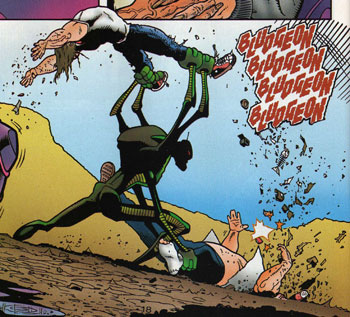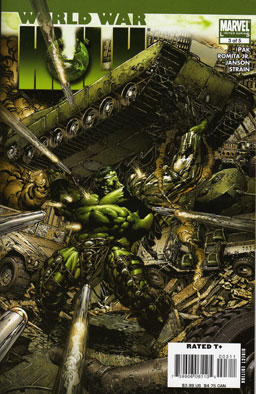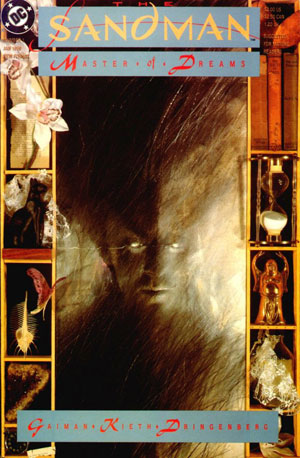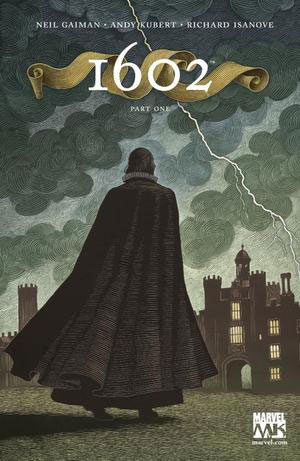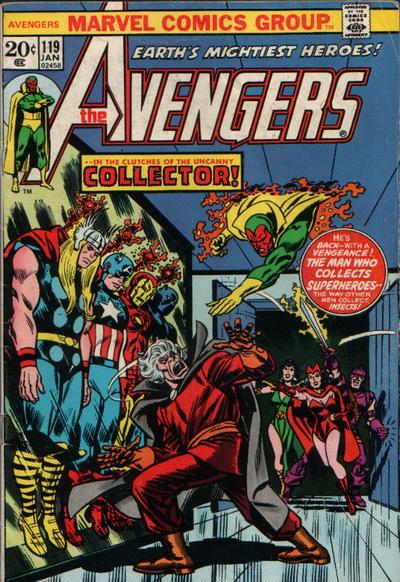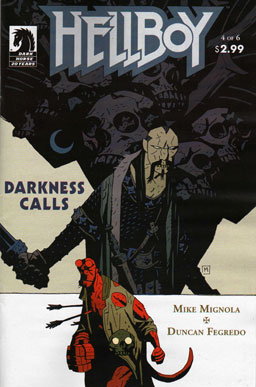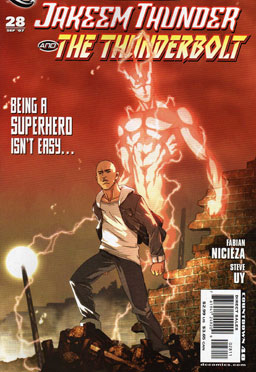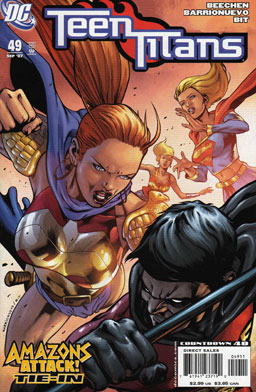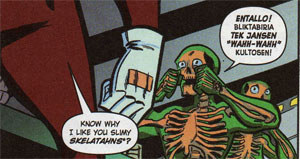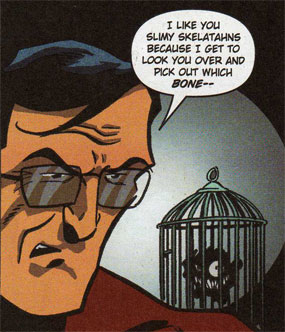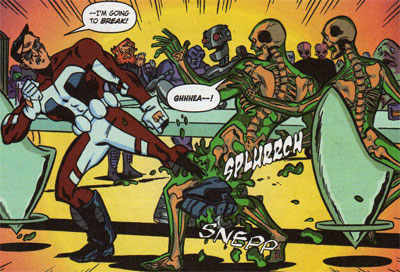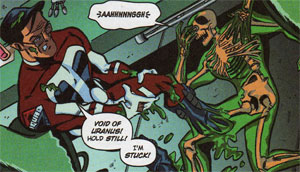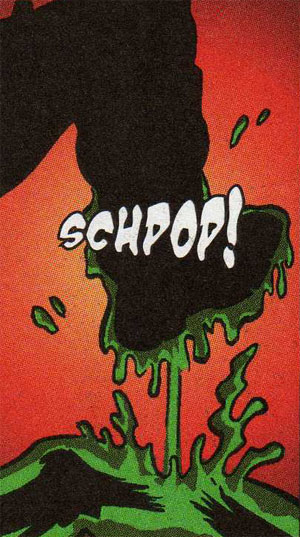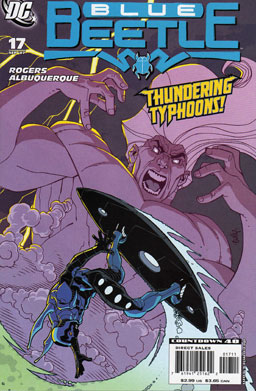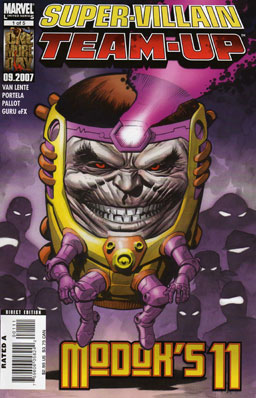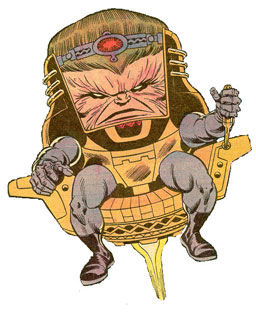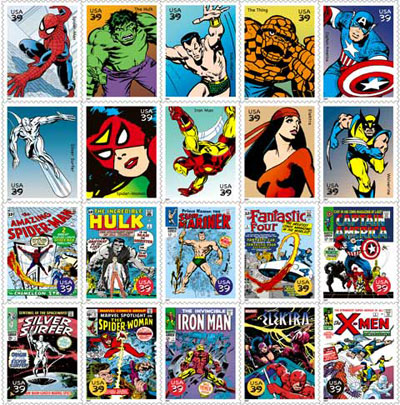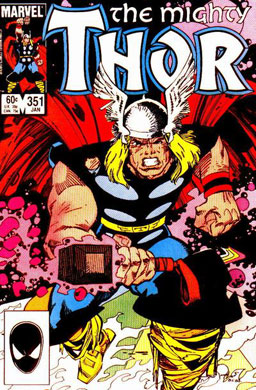
If there’s ever been a comic character whose adventures should’ve always been Capital-E Epic, it’s Marvel’s Thor. Yeah, he’s a god, and a thunder god to boot. And he’s got the most dynamic pantheon. Sure, the Olympians are older, but they spent all their time turning into swans and chasing maidens and letting mortals do all the hard work. Sure, the Egyptians were even older than that, but they always seemed mummified and remote.
But the Norse gods had epic poetry and operas. Operas by Wagner, let’s not forget. They had mad dwarfs, frost giants, Valkyries, a giant ash tree that held up the world. Norse mythology even came with a prepackaged End-of-the-World looming in the future, and their End-of-the-World was so cool, they called it Ragnarok. That’s one heck of a name. Say it out loud. Ragnarok. Say it loud enough and heavy metal bands will start following you around.
But even with all that, Thor still ran around the Big Apple, fighting bank robbers, hanging out with a drunk in powered armor, being waited on by an English butler named Jarvis.
Then in 1983, a guy named Walt Simonson started working on “The Mighty Thor.” And Simonson made Thor Epic.
David L. Wyatt Jr. has written an essay on Simonson’s run on Thor’s comic, called “Simonson in Asgard,” and with his kind permission, I’m going to reprint it here. If you want to see it in its original form, just click here, but David has very kindly given his permission to have it reprinted here.
Simonson in Asgard
by David L. Wyatt Jr.
When a new writer takes over an established comic book it may seem like smooth sailing. You have a ready stock of villains and supporting characters. The book has loyal fans who bought every issue since number six and almost certain to buy the next one. You have a franchise. As the old saying goes, if it ain’t broke, don’t fix it.
But the safe route leads to mediocrity and inevitable decline. The regulars will continue to buy until they grow up and demand more. New readers will look for the stories that excite them. Even the strengths of an established title, a well-developed roster of supporting characters and villains, a worldview, can become crutches if the writer repeats him or herself. To reach out to readers who have never before considered the book you must introduce change. But change carries certain dangers. Change risks angering the book’s loyal fans, who expect the writer to maintain consistency with issue number six. Change and you toss away many established advantages. Bruce Wayne can grow old in a miniseries, but in the regular Batman series Wayne must remain thirty, and no one dare suspect his true identity.
This was the situation when Walt Simonson took over Marvel Comics’ Thor. Thor had a rich history. The comic was the brainchild of comic legends Stan Lee and Jack Kirby. It had a variety of Lee’s original characters and the whole of Norse mythology to mine. But the comic had its faults as well. Ragnarok is supposed to be the end of everything. This cataclysmic struggle took place every third year. Odin was little more than temperamental father. The supporting characters were full of weaknesses.
Let us consider Thor’s secret identity, Dr. Donald Blake. When the book was begun all superheroes needed a secret identity. It was a time honored cliche. But why in the world would a God need a secret identity? Thor already had an identity, thank you, and one developed over several millennia. The idea of his father trapping him in the hammer to teach “humility” ought to summon an army of social workers. Silliness abounded everywhere. Heimdall, all-seeing Guardian of the rainbow bridge, spent eternity at his post without even a potty break. Balder the Brave was the most joyous and pure hearted person who happened to have slain a few thousand in combat, and a few dozen deaths. Balder remained merry, and endlessly willing to blindfold himself in the face of mistletoe. You’d think after the thirtieth death he might learn.
But the biggest absurdity was Volstagg. Corpulent, gigantic, clad in a puffy maroon tunic with a gold cap topped with long corn leaves, Volstagg looked more like a professional wrestling manager than a God. He could be counted upon to hide, and then come out with bombastic egotism to claim how his large stomach had turned into the key of victory. Worse, he was supposedly one of the “Warriors Three” with dashing Fandral and Hogun the Grimm. Now ask yourself, “Why in the world would Errol Flynn and Omar Sharif hang out with Fat Albert?” More than any other character, Volstagg symbolized the fact that Thor had fallen into cliche.
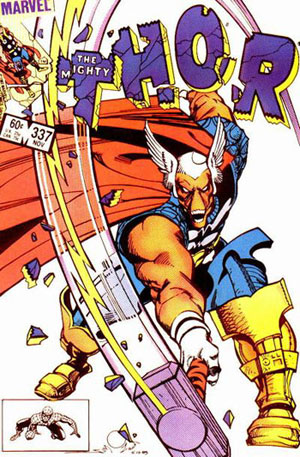
Until Thor #337. Simonson starts conventionally enough, Nick Fury sends Thor to intercept an alien vessel approaching earth. Thor awakens its protector, Beta Ray Bill. Like all superheroes meeting for the first time, they fight. Pretty much normal stuff, except for one thing: Thor tosses the hammer at Bill, and Bill picks it up. Thor suddenly becomes Donald Blake. And when Odin calls his son to Asgard, he gets the wrong hero.
The next issue Bill and Thor fight again, this time for possession of Mjolnir. And, once again, Bill wins– admittedly abetted by the rather hot place Odin chose for the fight. Again pretty normal stuff, except for the hero losing a rematch.
But in issue #339 we begin to see where Simonson is heading. He’s mining a deeper vein of gold, moving away from the more obvious conflicts into the nuts and bolts of Norse myth. Bill is worthy to lift Mjolnir. Which means he’s honest, and wouldn’t even consider taking the Hammer if his people weren’t facing a dire threat. So instead of simply claiming his prize he asks Odin if there might be a solution to this dilemma. Odin hears and sees both wisdom and nobility in Bill. And so Odin goes dressed as traveler into the land of the dwarves. But Eitri the Dwarf leader recognizes the all father, for Eitri too is wise. One issue minor characters begin to take on a richness normally absent in comics.
Other characters change in subtle ways. No one more than Volstagg. Oh he’s still the self aggrandizing King of the Clean Plate Club, but Volstagg is no longer just a buffoon. He knows he’s compulsive, and even a bit of a joke, but because he understands pain he can see it in others. Simonson reinterpreted Volstagg as jester rather than joke. He becomes serious when appropriate, brave when required, and silly when the tension needs relief. Volstagg belongs in the Warrirors Three for the things he does away from battle.
Simonson introduces that rarest of comic book virtues, character growth. Balder the pure hearted finally began to feel the deaths he has caused. Suffering from depression, Balder has forsaken the sword. Volstagg alone suspects what consumes Balder. When a younger warrior comes to challenge Balder, Volstagg easily disarms him. But he is not angered to see his friend challenged. Rather Volstagg sees in the lad the impetuous ambition of youth. Sitting on the youth, he becomes a mentor
Ragnarok does come to Asgard. But Simonson builds it slowly, and mines the full depth of Viking myth. In issues 342 and 343 he fills the last seat in Valhalla. Odin works quietly against what he fears, with sad resignation almost never seen in comics. A quiet moment with his wife says more than a thousand podium speeches. The End of All brings great fear, not glorious adventure.
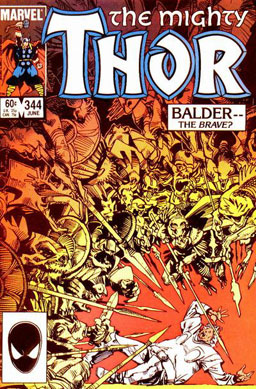
In 344 Simonson transforms Loki, the God of Mischief. Loki is often portrayed as malicious force, a powerful sorcerer but little different from any other supervillain. But in 344 Simonson displays a real Loki, one whose humor and malice the Joker might envy. For Balder has been sent by Odin to summon the trickster to Asgard, to aid in the struggle against Ragnarok. And the brave has forsworn violence, and killing. Naturally, Loki forces Balder into lots of killing, sending thousands of cannon fodder against the Asgardian. Until in desperation Balder himself is forced to take up the sword, and slay his way into Loki’s castle. There in Loki’s castle, in front of the destroyer Surtur’s servant Malekith the Dark Elf, Loki summarily refuses to read Odin’s proposition. In a moment of rage at what he has been forced to do, in vain, Balder decapitates Loki with a single stroke, then exiles himself to the desert.
A lesser writer might have let the suspense of Loki’s ‘death’ hang. But not Simonson. Instead the headless body of Loki searches for his head, until he finds and re-attaches it. Loki is in stitches, for the agonized look on Balder’s face proved “an excellent jest, one well worth the price of a stiff neck for a day or so. Balder, thy name is laughter.”
Issue by issue the tension builds. Malekith the dark elf schemes to take the Casket of Ancient Winters, that once released can freeze the barrier Odin’s bothers used to seal Surtur in the realm of flame, away from Asgard and Midgard, the Norse name for our Earth. But the casket is shattered and Surtur’s endless minions released into this world. Ragnarok has come.
But instead of facing the enemy alone, all of Earth unites against the forces of Muspellheim. Reed Richards and the Fantastic Four come to battle.. The warriors of Valhalla fight along side US Army divisions. Odin, Thor and Heimdall await Surtur in Asgard. If Surtur passes them he can set his sword alight, and burn the nine worlds to nothingness. Surtur seems invincible. Heimdall falls and the Rainbow Bridge is shattered. Thor is defeated, and unable to use his full power. Odin too is brushed aside. And at his moment of triumph Surtur finds himself confronted by Loki.
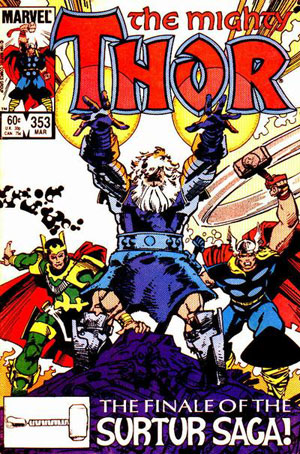
The battle is one of the finest in comics, with many little contributions summing up to a greater whole, Surtur versus Odin, Thor and Loki — for Asgard, Midgard, and as Loki put it, “for Myself.”
Of course the tribulations of Thor are only beginning. Before it ends he will have been turned into a frog, had his bones ground to dust, fought his way in and out of Hel, had Hela refuse him death in torment, then forced the Death Goddess regret her decision. He will fight the Midgard Serpent and fall before it, and yet not fall into death. Heimdall, the stoic all-seeing guardian of the Rainbow Bridge will prove that not only has he seen and heard everything, but thought about what all this meant. He well matches wits with Loki. Heimdall even bags a babe. Volstagg gets trapped in Manhattan to the delight of New York restauranteurs. Thor gets a job. All of which is in the greatest of fun.
No writer, before or since, has done to Thor what Simonson did. His run at that comic rivals the Watchmen and Frank Miller’s The Dark Knight, for its sheer inventiveness. Perhaps the Dark Knight is the best comparison, for in it Miller took Gotham and made it the same, yet completely different. The rainbow bridge still links Asgard and Midgard. But because of Simonson, Asgard could never be the same.
Simonson issues: (his art and script until otherwise noted)
#337 ” ” (November 1983)
#338 A Fool and His Hammer . . .
#339 Something Old, Something New ..
#340 Though Hell Should Bar the Way
#341 The Past is a Bucket of Ashes
#342 The Last Viking
#343 If I Should Die Before I Wake
#344 Whatever Happened to Balder the Brave?
#345 That Was No Lady!
#346 The Wild Hunt
#347 Into the Realm of Faerie
#348 The Dark and the Light
#349 Debts of Honor
#350 Ragnarok and Roll!
#351 Ragnarok and Roll, too!
#352 Ragnarok and Ruin
#353 Doom II
#354 Pickin’ up the Pieces
#355 The Icy Hearts (or My Dinners with Thor!) — pencils and inks by Sal Buscema
#357 A New Deal from an Old Deck (or Credit Card Soldiers) ? art by Simonson
#358 When Dalliance was in Flower (or Take the Cash and let the Credit Go)
#359 The Grand Alliance (or Life with Loki)
#360 Into the Valley of Death
#361 The Quick and the Dead
#362 Like a Bat out of Hel!
#363 This Kursed Earth . . ..
#364 Thor Croaks!
#365 Guess Who’s Coming to Dinner (or It’s Not Easy Being Green)
#366 What do you call a 6’6′ Fighting Mad Frog? Sir!
#367 The Harvest of the Seasons
#368 The Eye of the Beholder —- art by Sal Buscema
#369 For Whom the Belles Troll—- art by Buscema & Geoff Isherwood
#371 Peace on Earth art by Buscema & Albret Blevinson
#372 Without Justice, there is no Peace art by Buscema & Bevinson
#373 The Gift of Death art by Buscema
#374 Fires of the Night art by Buscema
#375 Shadows of the Past art by Buscema
#376 Heroes Always Win . . . Don’t They? Art by Buscema
#377 This Hollowed Armor art by Buscema
#378 When Loki Stood Alone art by Buscema
#379 There were Giants in Those Days (or, a Discussion between Heroes and Villains) Art by Buscema
#380 Mjolnir’s Song
#381 Ye Olde Shelle Game! art by Buscema
#382 Journey Into Mystery art by Buscema
(August 1987)

